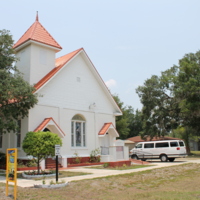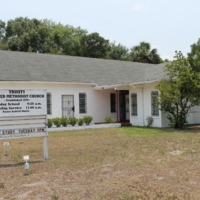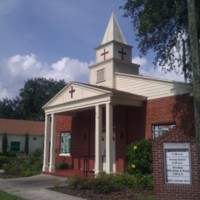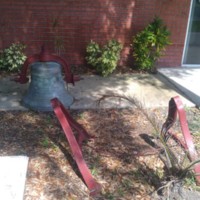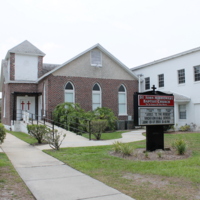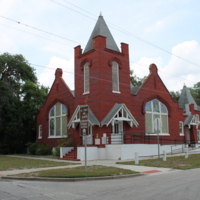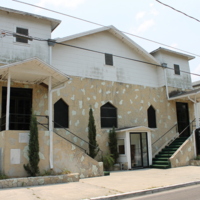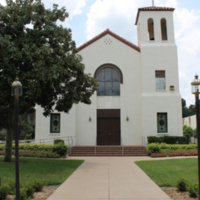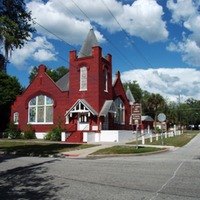Churches of Sanford Collection
Dublin Core
Title
Churches of Sanford Collection
Alternative Title
Sanford Churches Collection
Subject
Sanford (Fla.)
Churches--Florida
Description
Collection of digital images, documents, and other records depicting the religious history of Sanford, Florida. Series descriptions are based on special topics, the majority of which students focused their metadata entries around.
The present-day Sanford area was originally inhabited by the Mayaca/Joroco natives by the time Europeans arrived. The tribe was decimated by war and disease by 1760 and was replaced by the Seminole Indians. In 1821, the United States acquired Florida from Spain and Americans began to settled in the state.
Camp Monroe was established in the mid-1830s to defend the area against Seminoles during the Seminole Wars. In 1836, the United States Army built a road (present-day Mellonville Avenue) to a location called "Camp Monroe," during the Second Seminole War. Following an attack on February 8, 1837, the camp was renamed "Fort Mellon," in honor of the battle's only American casualty, Captain Charles Mellon.
The town of Mellonville was founded nearby in 1842 by Daniel Stewart. When Florida became a state three years later, Mellonville became the county seat for Orange County, which was originally a portion of Mosquito County. Citrus was the first cash crop in the area and the first fruit packing plant was constructed in 1869.
In 1870, a lawyer from Connecticut by the name of Henry Shelton Sanford purchased 12,548 acres of open land west of Mellonville. His vision was to make this new land a major port city, both railway and by water. Sitting on Lake Monroe, and the head of the St. Johns River, the City of Sanford earned the nickname of “The Gate City of South Florida.” Sanford became not only a transportation hub, but a leading citrus industry in Florida, and eventually globally.
The Great Fire of 1887 devastated the city, which also suffered from a statewide epidemic of yellow fever the following year. The citrus industry flourished until the Great Freezes of 1894 and 1895, causing planters to begin growing celery in 1896 as an alternative. Celery replaced citrus as the city's cash crop and Sanford was nicknamed "Celery City." In 1913, Sanford became the county seat of Seminole County, once part of Orange County. Agriculture dominated the region until Walt Disney World opened in October of 1971, effectively shifting the Central Florida economy towards tourism and residential development.
The present-day Sanford area was originally inhabited by the Mayaca/Joroco natives by the time Europeans arrived. The tribe was decimated by war and disease by 1760 and was replaced by the Seminole Indians. In 1821, the United States acquired Florida from Spain and Americans began to settled in the state.
Camp Monroe was established in the mid-1830s to defend the area against Seminoles during the Seminole Wars. In 1836, the United States Army built a road (present-day Mellonville Avenue) to a location called "Camp Monroe," during the Second Seminole War. Following an attack on February 8, 1837, the camp was renamed "Fort Mellon," in honor of the battle's only American casualty, Captain Charles Mellon.
The town of Mellonville was founded nearby in 1842 by Daniel Stewart. When Florida became a state three years later, Mellonville became the county seat for Orange County, which was originally a portion of Mosquito County. Citrus was the first cash crop in the area and the first fruit packing plant was constructed in 1869.
In 1870, a lawyer from Connecticut by the name of Henry Shelton Sanford purchased 12,548 acres of open land west of Mellonville. His vision was to make this new land a major port city, both railway and by water. Sitting on Lake Monroe, and the head of the St. Johns River, the City of Sanford earned the nickname of “The Gate City of South Florida.” Sanford became not only a transportation hub, but a leading citrus industry in Florida, and eventually globally.
The Great Fire of 1887 devastated the city, which also suffered from a statewide epidemic of yellow fever the following year. The citrus industry flourished until the Great Freezes of 1894 and 1895, causing planters to begin growing celery in 1896 as an alternative. Celery replaced citrus as the city's cash crop and Sanford was nicknamed "Celery City." In 1913, Sanford became the county seat of Seminole County, once part of Orange County. Agriculture dominated the region until Walt Disney World opened in October of 1971, effectively shifting the Central Florida economy towards tourism and residential development.
Contributor
MacDonald, Kathleen
Smith, Austin
Is Part Of
Sanford Collection, Seminole County Collection, RICHES of Central Florida.
Language
eng
Type
Collection
Coverage
All Souls Catholic Church, Sanford, Florida
New Mount Calvary Baptist Church, Sanford, Florida
St. Paul Missionary Baptist Church, Sanford, Florida
St. John Missionary Baptist Church, Sanford, Florida
St. James African Methodist Episcopal Church, Sanford, Florida
Trinity United Methodist Church, Sanford, Florida
Zion Hope Missionary Baptist Church, Sanford, Florida
Curator
Cepero, Laura
Digital Collection
External Reference
Joiner, E. Earl. A History of Florida Baptists. Jacksonville, Fla: Printed by Convention Press, 1972.
Bailey, Julius. Around the Family Altar: Domesticity in the African Methodist Episcopal Church, 1865-1900. Gainesville, FL: University Press of Florida, 2005.
Gannon, Michael. The Cross in the Sand: The Early Catholic Church in Florida, 1513-1870. Gainesville: University of Florida Press, 1965.
Collection Items
Zion Hope Missionary Baptist Church, 2011
Zion Hope Missionary Baptist Church, located at 710 Orange Avenue in Georgetown, an African-American community in Sanford, Florida, in 2011. Zion Hope was founded in a brush arbor, under the leadership of Reverend Wash Levingston, on June 9, 1888.…
Trinity United Methodist Church, 2011
Trinity United Methodist Church (UMC), located at 526 South Sanford Avenue in Georgetown, an African-American community in Sanford, Florida, in 2011. Trinity UMC was originally named the New Mount Zion Colored Methodist Episcopal (CME) Church and…
St. Paul Missionary Baptist Church, 2011
St. Paul Missionary Baptist Church, located at 813 Pine Avenue in Georgetown, an African-American community in Sanford, Florida, in 2011. Considered the oldest African-American Baptist church in Sanford, St. Paul Missionary Baptist Church was first…
St. Paul Missionary Baptist Church Bell
St. Paul Missionary Baptist Church, located at 813 Pine Avenue in Sanford, Florida in 2011. Considered the oldest African-American Baptist church in Sanford, Florida, St. Paul Missionary Baptist Church was first organized under an arbor brush in…
St. John Missionary Baptist Church, 2011
St. John Missionary Baptist Church, located at 920 Cypress Avenue in Georgetown, an African-American community in Sanford, Florida, in 2011. St. John was organized under the leadership of Reverend M. W. Evans on May 10, 1895. Within a few years, the…
St. James African Methodist Episcopal Church, 2011
St. James African Methodist Episcopal (AME) Church, located at 819 Cypress Avenue in Sanford, Florida, in 2011. The history of St. James AME Church reaches far back into the history of Florida and the American Civil War. Immediately following the…
New Mount Calvary Baptist Church, 2011
New Mount Calvary Missionary Baptist Church, located at 1115 West Twelfth Street in Goldsboro, an African-American community in Sanford, Florida, in 2011. New Mount was founded in 1918 by former members of the First Shiloh Missionary Baptist Church,…
All Souls Catholic Church Historic Chapel, 2011
The All Souls Catholic Church, located at 800 South Oak Avenue in Sanford, Florida, in 2011. All Souls Catholic Church was founded by Father McFaul in 1882 and is one of the oldest Catholic parishes in Central Florida. The original church building…
St. James African Methodist Episcopal Church
View of St. James AME Church from the intersection of Cypress Avenue and East 9th Street. The church itself was founded in 1867 at another location off of Mellonville Avenue. In 1880, the church purchased land at the current location from the Florida…
Collection Tree
- Seminole County Collection
- Sanford Collection
- Churches of Sanford Collection
- Sanford Collection
